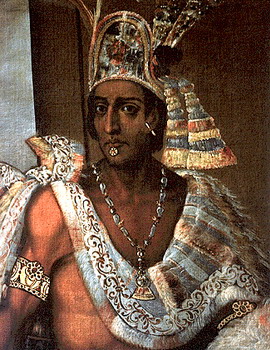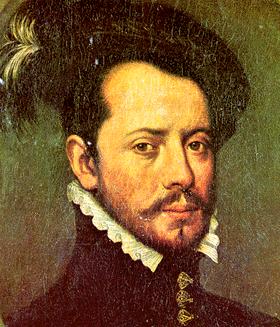The Encounter is a term used to describe the collision of Native Americans from the "New World" and the Europeans from the "Old World" during the 15th and 16th Centuries. Before the arrival of Iberians in Latin America, the indigenous people had their own distinct culture and ideals. After the conquest of the indigenous people, the conquistadors imposed their own societal standards on the indigenous population, creating a new vision of the "ideal" Latin American.

Montezuma II
Indigenous
Since the indigenous people were technically the first in Latin America, their vision of the ideal Latin American should be considered first. According to Victor Alba, "the Indians had a collectivist outlook: for them, one's individual existence was bound up in the collective being" (20). The indigenous people valued hard workers who were dedicated to improving the collective well-being. While each person was valued in indigenous societies, some skills were more important than others. For example, indigenous societies relied on agriculture, fishing, and hunting to survive. Traditionally, many indigenous tribes were based on war. Tribes constantly fought each other for power. So overall, military prowess would be one of their most sought-after characteristics. Also, tribe loyalty was of importance among many indigenous tribe members. Many times, traitors to a tribe would be shunned or even killed. Montezuma was a Mexica leader that served as the Aztec emperor. Montezuma was a warlord who had power from the battles where he lead his people to victory, embodying the ideal indigenous Latin American male.
The ideal indigenous woman would be less violent and more sedentary. In describing the ideal Latin American woman, it may be easier to look at a counterexample. Malinche was not ideal by any standards, but she did not make history for following the norms of her society. She was sexually promiscuous, something that usually was only acceptable for men. Malinche sought vengence and was not sedentary or complacent in her role. She worked side by side with Cortés as a translator and one of his many lovers and was partially reponsible for the Spanish defeat of the Aztec Empire. For this act, Malinche was seen as a traitor by her poeple. This was an unfair judgement since her own family sold her into slavery. Malinche felt no loyalty towards her family or her tribe giving her no reason to not help Cortés. The indigenous people believed firmly in the idea of loyalty, which Malinche went against. The ideal woman would instead be content raising her family, making food, taking care of the house, and most importantly, staying loyal to her family. Even though Malinche fought, to the best of her ability and for her best interest, she was viewed as a traitor by the indigenous people, and was not an ideal indigenous woman. All in all, the indigenous view of the ideal Latin American was very different from the Iberian view of an ideal citizen.
The Aztec princess Techichipotzin, or better known as "Isabel Moctezuma" comes close to the ideal woman of indigenous nobility who then adapted to become an ideal woman of Spanish culture. As Moctezuma's daughter she was already greatly respected among the Aztecs and was an image of indigenous royalty. According to Chasteen, she could attract a Spanish husband, because of her wealth and beauty (39). She had her pick of many men and was married and widowed twice by the age of twelve. She adapted to her new life as a Catholic, became a model of devotion and gave generously to religious charities. However, throughout her Catholic studies she was never taught to read and remained illiterate. Doña Isabel was of value to Cortés, because she represented the continuity of rule between the Aztecs and the Spanish. After murdering her third husband, Cortés arranged for Doña Isabel to marry a close friend. Cortés granted her a large encomienda, demonstrating her importance. The Spanish and later Mexican governments paid royalties in the form of pension to Doña Isabel's descendants until the 1930's. After being widowed for the fourth time, Cortés took her into his home and she quickly became pregnant. Their romance, if there had been one, ended and Cortés quickly married her off to another associate and the child was born a few months later. Doña Isabel apparently did not accept the child as her own and she was raised by another friend of Cortés. However, according to Wikipedia, Cortés did accept the child and made sure she was brought up well and given a large inheritance from both he and Isabel's estate showing that he thought highly of Isabel. Doña Isabel is an ideal Latin American because she represents a determined and strong woman who was also kind and generous. She represents an ideal mixture between both the Aztec and Spanish cultures. Whether it was by choice or force, Doña Isabel is the prime historical example of Spanish assimilation and she characterized Mexico's future.
Iberians
Iberian conquistadors brought their own ideals from Spain and Portugal to the New World. This included what qualities a person should value. Their initial description as stated in Chasteen’s “Born in Blood and Fire” was, “The Iberian invaders of America were personally no more sinful than most. They came to America seeking success in the terms dictated by their society: riches, the privilege of being served by others, and a claim to religious righteousness” (11). In a broad sense, the Iberians believed that the most idealistic person would focus primarily on the three g’s: God, gold, and glory. In terms of their physical characteristics, "the conquistadors were often younger [men]... who captained groups of peasants hastily turned soldiers, inured work and fatigue, and able to learn quickly and adapt themselves to unfamiliar climate and labor" (Alba 23).

Hernan Cortes (1485-1547)
Hernán Cortés embodied the ideal characteristics of a Spanish conquistador. Cortés led the Iberians to defeat the entire Aztec empire. When the Spanish first arrived at Tenochtitlan, Montezuma welcomed Cortés with open arms and numerous gifts. Later, fearing an attack, Cortés took Montezuma hostage and eventually defeated the empire. Although the defeat of the empire was completely attributed to Cortés, in reality, the Spanish won due to their superior technology and military tactics. Cortés used allied tribes to gain indigenous support and trust, thus allowing him to later gain the trust of Montezuma himself. The Spanish also brought guns with them, a technology completely alien to the indigenous people. This superiority in technology gave the Spanish an advantage over the indigenous, although Cortés lacked many soldiers. Therefore, even though this Spanish victory wasn’t necessarily due to Cortés, he was still the figurehead during this landmark moment history. The Spanish people viewed him as intelligent, strong, and heroic, among many other things. Although he may have had other motives, he conquered the Aztec empire in the name of the Crown and the spread of Catholicism.
The ideal Spanish-Latin American woman would probably never make history, because she should not draw attention to herself. She would be Catholic and a housewife or nun. As a wife, her persuits would be raising her children as good Catholics, teaching them to be obedient, and taking care of the house. She would be completely subservient to her husband, though she would be in charge of everything in the house. She would not be literate whatsoever or she would only read religious books and the Bible. A life as a housewife was what most of the women during the time chose to do. Although it was the less common path, some women chose to spend their lives devoted to God and spreading their religion. As a nun, she would pray, study scripture and holy books, and do a craft in the convent. They had more freedom than wives, but were still not in charge of their lives. Some women that lived as nuns used their freedom for self-discovery and education even though this was not an acceptable norm for women. The ideal Spanish-Latin American women were subservient and docile while staying within social norms and expectations.
A New Society
The Iberian conquerors, with their own personal ideals, came to Latin America and imposed these standards on the indigenous people, resulting in a combined version of these ideals. The encomienda system rewarded the conquistadors with people, if they agreed to Christianize the natives in the name of the crown. This resulted in a newly formed society, largely built up of three groups: the indigenous populations, Iberian conquerors, and African slaves (who were brought by Europeans). This new societal structure caused a change in Latin American ideals.